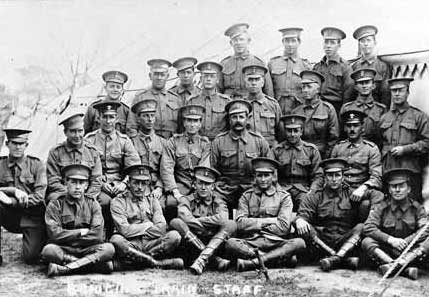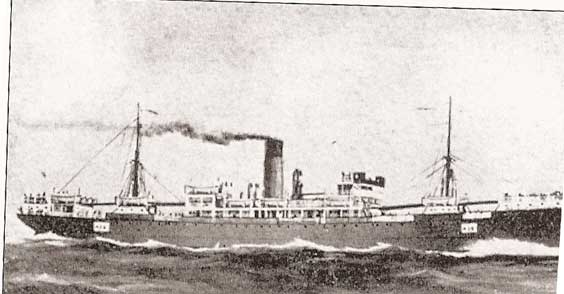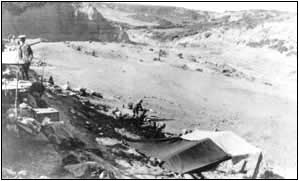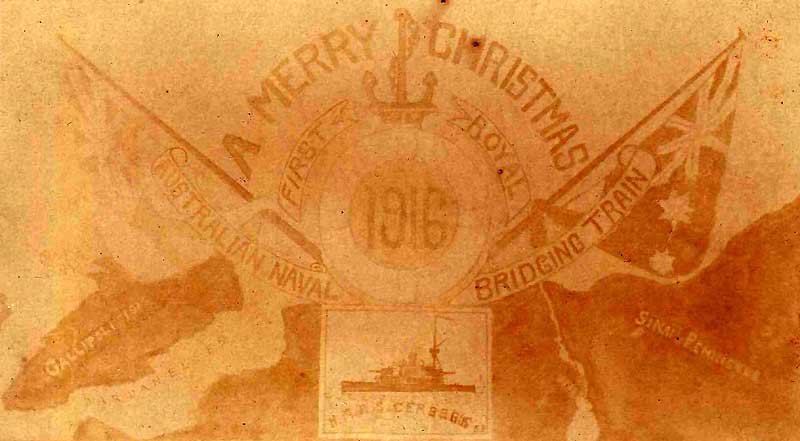Introduction.
A great deal has been written about the Diggers of the AIF at Gallipoli, and the birth of the ANZAC tradition. However, very little is known about a team of Australian Naval Reservists who made up the RAN Bridging Train who spent some four months ashore at Sulva Bay, north of Anzac Cove, and who were the last to leave in the evacuation of December 1915.

RAN Bridging Train Staff.
Federation in Australia.
When all of the Australian States federated in 1901 to form the new Commonwealth of Australia, this new body took over all the Colonial Naval Forces, and Victoria had by far the largest Navy of all the States.
The Royal Australian Reserve was a copy cat of the Royal Navy Reserve, and when WW1 broke out in 1914, the RAN Brigade numbered about 1,600 with another 3,000 in training.
Role of the RAN Brigade.
The Brigade's role was to undertake inspection of ships, cargoes, man Port Signal Stations, operate auxiliary coastal craft, guard ships and wharves, undertake intelligence and censorship duties, and later, man minesweeping vessels.
When a force was raised to attack German possessions in New Guinea in WW1, the Naval Brigade provided a contingent for service in that arena.
Offer to Great Britain.
Early in 1915, the Australian Government offered to provide a Naval Unit qualified in both engineering and technical support to help the Royal Naval Division fighting on shore in Flanders.
This offer read:
"One Bridging Train in accordance with Imperial War Establishments including personnel and their equipment, vehicles, horses. Personnel will be RANR and trained in bridging."
This offer was taken up on February 15th. 1915, and the Unit formed, commanded by Lieutenant Leighton Seymour Bracegirdle RAN, soon to be promoted to Lieutenant Commander. ( later a Rear Admiral. I served with his son Warrick who as a Lieutenant Commander was Gunnery Officer in HMAS Shropshire, and when a Commander was Captain of HMAS Bataan in the Korean war. )
Training began in Melbourne, most of the members were from the city, and unlike many of the army in the AIF, did not have horsemanship skills, so they needed to be taught how to handle horses and to ride.
On June 4th. and prior to all their training being completed the Unit embarked in HMAT Port Macquarie.

HMAT Port Macquarie
9 Officers and Warrant Officers that included a surgeon ear marked for Vet duties, and 340 other ranks went on board the trooper.
They loaded 412 horses, 50 pontoon and trestle wagons, plus 8 other vehicles.
The training in pontoon construction would be given on arrival in England.
The ship was diverted to Bombay at the end of June, 79 horses had died from heat exhaustion and infection, the balance were put ashore in Bombay.
At Port Said, the Unit was sent off to the Dardanelles, some what ironic is the fact that the RAN Reserve Unit is suddenly detached from the Navy, is placed under British Army control, and about to be faced with pontoon construction, the one aspect of their previous training yet to be completed.
RANBT. On April 25th. 1915, the Bridging Train was attached to the British 9th. Army Corps. From July 27th. to August 6th. their equipment was unloaded from their troopship, in anticipation of the Army Corps landing at Sulva Bay on August 7th.
In that period 5 days and nights of instruction about the managing and use of pontoons was provided at the very last hour. The RANBT was now involved in the Sulva Bay attack.
Bean the Australian Historian on Gallipoli has recorded:
"Lifeboats engaged in taking off the wounded . . . could not get within 100 yards of the shore; could the Australians put up as soon as possible a pier from which embarkation could proceed? At once the necessary pontoons and superstructure were prepared and rowed two miles . . . under continual shrapnel fire; a pier 120 yards long was erected in twenty minutes from the time of arrival, and was in full use five minutes later."
Bean, C. Official History of Australia in the War of 1914-1918 , Vol IX—The Royal Australian Navy: 1914-1918 (9th ed.). Angus & Robertson, Sydney.
Lieutenant Commander Bracegirdle reports on his Unit's duties.
"The principal duties allotted to the unit by the Royal Navy were . . . water supply, care of landing piers, discharging of stores . . . lighterage of same to shore, salving of lighters and steamboats wrecked . . . disembarking troops with their baggage . . . and of all munitions and stores . . . The duties allotted by the IX Army Corps were . . . control and issue of all engineer and trench stores and materials, care and issue of all trench bombs and demolition stores, . . . erection of high-explosive magazines, dug-outs, cookhouses and galleys, assembly of hospital huttings, . . . and the manning and control of the steam-tug Daphne ."

RAN Bridging Train behind the front line at Sulva Bay 1915.
Lack of Water Supply.
At the start of the landings the supply of water was poorly handled, and on August 12th. the RANBT was given the task of supplying all water from ships to shore, building of storage tanks, plus the distribution of the water, all in addition to their normal construction tasks.
Casualties low for RANBT.
The casualty rate for the RANBT was just over 10%, and the mortality rate was low, but this Unit was unable to fight back against any Turkish attacks, they were subjected to shot and shell as they went about their daily tasks.
Evacuation.
In December of 1915 troops were evacuated from the peninsula, a very successful operation, and the RANBT played a major role in its success.
When all the troops had been embarked, theTrain destroyed their equipment, and left the beach at 1930, by 0200 on December 18th. the RANBT had departed from Sulva Bay, they had been ashore for four months and now were the last to leave.
Decorations.
The RANBT was the most highly decorated RAN Unit in WW1, some 20 awards were made for bravery and good service.

Courtesy of Friends of the Cerberus
Conclusion.
Even today, 92 years after this extraordinary effort at Gallipoli, the exploits of the RAN Bridging Train remain little recognised.
I trust this short summary of what the Train achieved in such harsh conditions and with so little training will serve as a reminder to all the value and traditions of Reserve service. It is fitting that we should end with an excerpt from Bean who reported:
"There they are to-day, in charge of the landing of a great part of the stores of a British Army. They are quite cut off from their own force; they scarcely come into the category of the Australian Force, and scarcely into that of the British; they are scarcely army and scarcely navy. Who is it that looks after their special interests, and which is the authority that has the power of recognising any good work that they have done, I do not know. If you want to see the work, you have only to go to Kangaroo Beach, Suvla Bay, and look about you. They have made a harbour. "

RANBT remembered.





